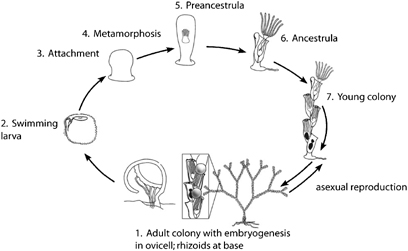Reproduction
The life cycle of the aquatic Bugula neritina is a very unique process. It undergoes sexual reproduction and asexual production in one life cycle. They thrive on hard surfaces and warm waters (Fuchs, et al 2011).
They begin with sexual reproduction, with each zooid of adult Bugula neritina having both female and male reproductive organs on the same organism, this means each zooid can produce sperm and egg gametes (Step 1 in Figure 1). In order to prevent self-fertilization, the eggs and sperm are released at different times of the lifespan. Eggs are produced in each zooid one at a time. The egg is located at the end where two branches of the colony come together; this structure is called the ovicell, which is a brood pouch. Within the ovicell, “coronate” larvae begin to develop (The Exotics Guide, 2011).
The “coronate” larvae do not have a functioning gut or they lack a gut all together. Because they lack a gut the developing larvae inside the enclosed pouch are unable to feed off of other living organisms. Instead they feed off of the yolk of the surrounding egg (Fuchs, et al 2011.). Usually around dawn, the fully developed larvae are released from the ovicell (Step 2 in Figure 1). Water is needed in order for the larvae to be released. While in the water, they search for a hard surface and attach to the surface (Step three in Figure 1). There, they begin to undergo metamorphosis into the ancestrula, which is the first feeding colony(Steps 5 and 6 in Figure 1). There, within the ancestrula is where asexual budding begins(Sharp, et al 2007).
These new cells are created from the body wall which creates polypides that are the branches of the Bugula neritina(Fuchs, et al 2011).
Reproduction cycle of Bugula neritina
